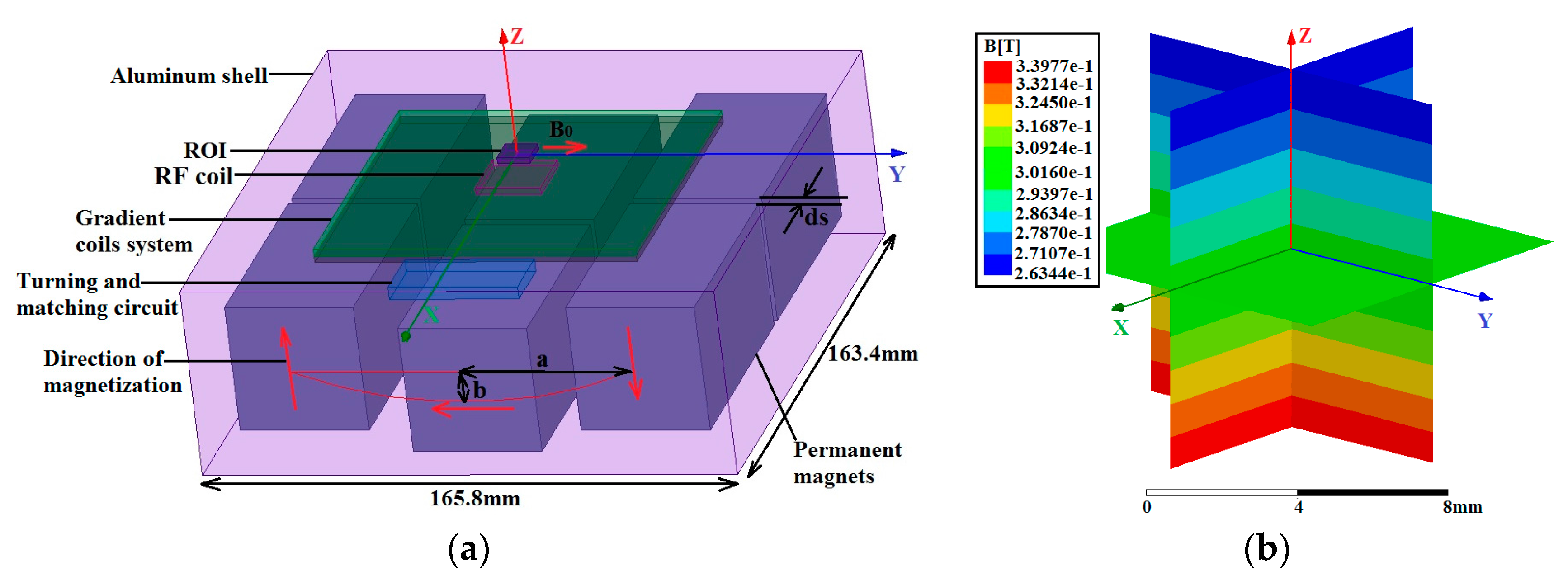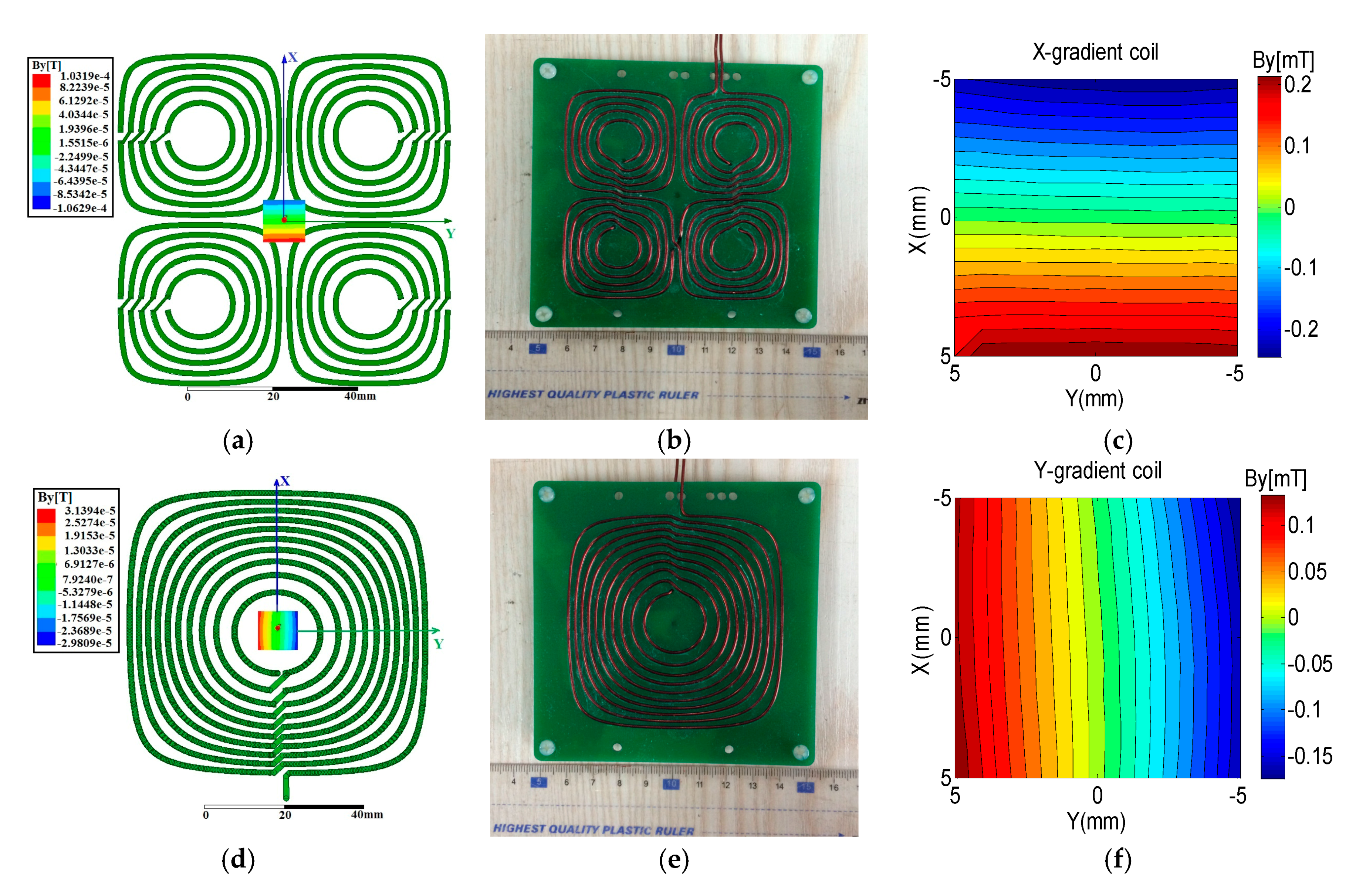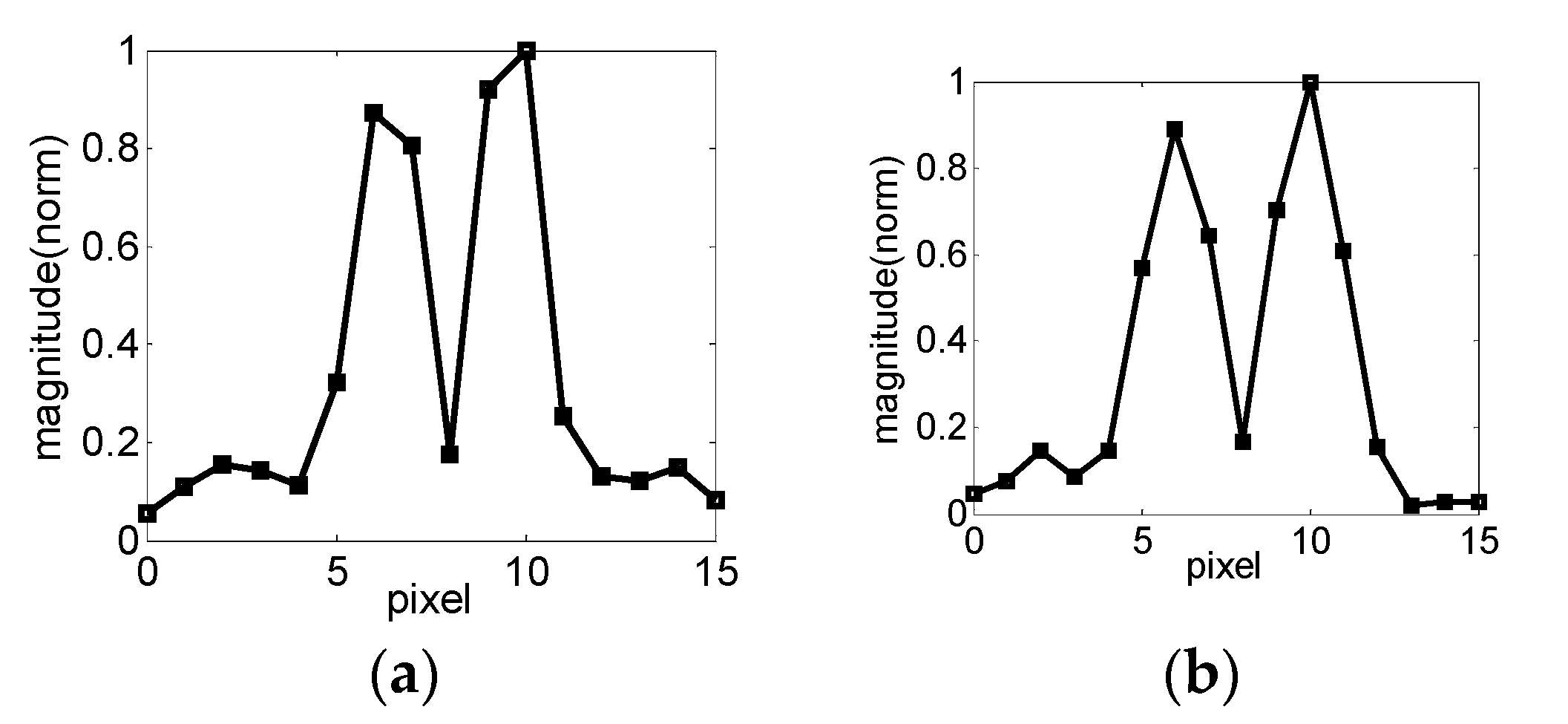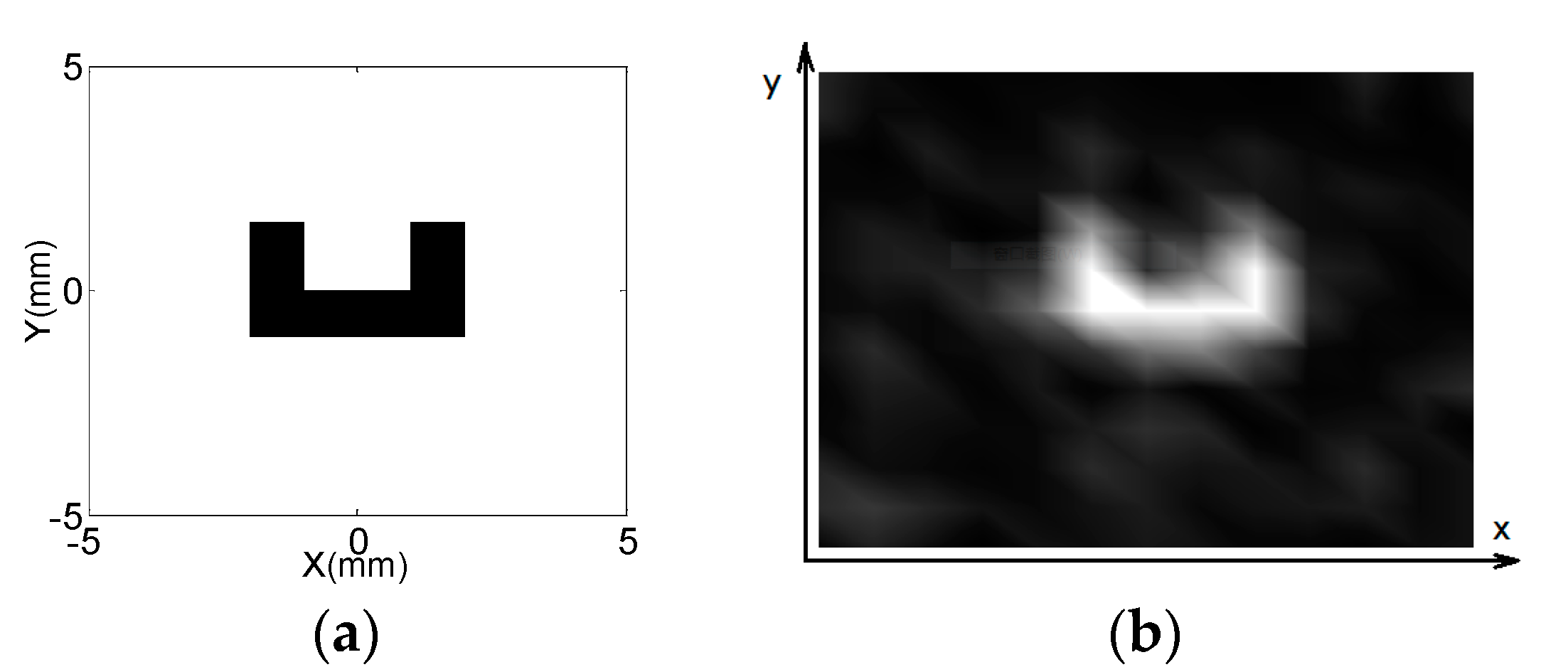The Novel Design of a Single-Sided MRI Probe for Assessing Burn Depth
Abstract
:1. Introduction
2. Sensor Design
2.1. Magnet System
2.2. Uniplanar Gradient Coils
2.3. Uniplanar RF Coil
3. Results and Discussions
4. Conclusions
- (1)
- The homogeneity of the B0 field should be improved to improve SNR. Because of the machining tolerance of the aluminum box, a deviation was observed between the measurement and simulation of the B0 field. Tolerance reduction and performing the shimming work could be considered in our future work.
- (2)
- An instability in the probe was observed. This instability could be attributed to the inconstant temperature because the magnetic field of NdFeB was susceptible to temperature. In the future, we will focus on adding a thermal vacuum insulation layer for the unilateral MRI magnet.
- (3)
- A signal-processing method and a faster imaging method will be considered to accelerate imaging times in unilateral MRI devices in our future work. Nevo’s group [9,31,32] has presented a statistical signal-processing method [31,32] to improve imaging capabilities by improving the extraction of image information from the noisy data, and has also presented modified compressed sensing (CS) and fast spin echo (FSE) methods [9] to accelerate imaging on a unilateral NMR scanner. Therefore, we will consider those methods to accelerate imaging in our unilateral MRI probe.
- (4)
- Additional information such as depth–relaxation map, depth–diffusion map [6] and T1 weighted image with a shortened repetition delay [13] will be utilized to assess burn depth. Both depth–relaxation map and depth–diffusion map can be provided by low-gradient unilateral MRI probe. For the low-gradient single-sided NMR sensor, the human skin can be profiled in one-shot. The difference in those maps between different burn degrees will be researched.
Acknowledgments
Author Contributions
Conflicts of Interest
References
- Monstrey, S.; Hoeksema, H.; Verbelen, J.; Pirayesh, A.; Blondeel, P. Assessment of burn depth and burn wound healing Potential. Burns 2008, 34, 761–769. [Google Scholar] [CrossRef] [PubMed]
- Devgan, L.; Bhat, S.; Aylward, B.; Spence, S. Modalities for the assessment of burn wound depth. J. Burns Wounds 2006, 5, 7–15. [Google Scholar]
- Heimbach, D.; Afromowitz, M.; Engrav, L.; Marvin, J.; Perry, B. Burn depth estimation—Man or machine. J. Trauma Acute Care Surg. 1984, 24, 373–378. [Google Scholar] [CrossRef]
- Casanova, F.; Perlo, J.; Blumich, B. Single-Sided NMR; Springer: Berlin, Germany, 2011. [Google Scholar]
- Mcdonald, P.J.; Akhmerov, A.; Backhouse, L.J.; Pitts, S. Magnetic resonance profiling of human skin in vivo using GARField magnets. J. Pharm. Sci. 2005, 94, 1850–1860. [Google Scholar] [CrossRef] [PubMed]
- Van Landeghem, M.; Danieli, E.; Perlo, J.; Blumich, B.; Casanova, F. Low-gradient single-sided NMR sensor for one-shot profiling of human skin. J. Magn. Reson. 2012, 215, 74–84. [Google Scholar] [CrossRef] [PubMed]
- Casanova, F.; Blumich, B. Two-dimensional imaging with a single-sided NMR probe. J. Magn. Reson. 2003, 163, 38–45. [Google Scholar] [CrossRef]
- Perlo, J.; Casanova, F.; Blumich, B. 3D imaging with a single-sided sensor: An open tomograph. J. Magn. Reson. 2004, 166, 228–235. [Google Scholar] [CrossRef] [PubMed]
- Liberman, A.; Bergman, E.; Sarda, Y.; Nevo, U. Faster imaging with a portable unilateral NMR device. J. Magn. Reson. 2013, 231, 72–78. [Google Scholar] [CrossRef] [PubMed]
- Demas, V.; Sakellariou, D.; Meriles, C.A.; Han, S.; Reimer, J.; Pines, A. Three-dimensional phase-encoded chemical shift MRI in the presence of inhomogeneous fields. Proc. Natl. Acad. Sci. USA 2004, 101, 8845–8847. [Google Scholar] [CrossRef] [PubMed]
- Blumich, B.; Blumler, P.; Eidmann, G.; Guthausen, A.; Haken, R.; Schmitz, U.; Saito, K.; Zimmer, G. The NMR-MOUSE: Construction, excitation, and applications. Magn. Reson. Imaging 1998, 16, 479–484. [Google Scholar] [CrossRef]
- Manz, B.; Coy, A.; Dykstra, R.; Eccles, C.D.; Hunter, M.W.; Parkinson, B.J.; Callaghan, P.T. A Mobile one sided NMR sensor with a homogeneous Magnetic field: The NMR-MolE. J. Magn. Reson. 2006, 183, 25–31. [Google Scholar] [CrossRef] [PubMed]
- Paulsen, J.L.; Bouchard, L.S.; Graziani, D.; Blumich, B.; Pines, A. Volume selective magnetic resonance imaging using an adjustable, single sided, portable sensor. Proc. Natl. Acad. Sci. USA 2008, 105, 20601–20604. [Google Scholar] [CrossRef] [PubMed]
- Marble, A.E.; Mastikhin, I.V.; Colpitts, B.G.; Balcom, B.J. A constant gradient unilateral magnet for near-surface MRI profiling. J. Magn. Reson. 2006, 183, 228–234. [Google Scholar] [CrossRef] [PubMed]
- He, W.; He, Z. A hybrid passive shimming method applied to the design of a unilateral NMR magnet. Int. J. Appl. Electromagn. Mech. 2015, 49, 597–606. [Google Scholar] [CrossRef]
- Cho, Z.H.; Yi, J.H. A Novel Type of Surface Gradient Coil. J. Magn. Reson. 1991, 94, 47l–485. [Google Scholar] [CrossRef]
- Vegh, V.; Zhao, H.; Galloway, G.J.; Doddrell, D.M.; Brereton, I.M. The Design of Planar Gradient Coils. Part I: A Winding Path Correction Method. Concepts Magn. Reson. B Magn. Reson. Eng. 2005, 27B, 17–24. [Google Scholar] [CrossRef]
- Turner, R. A target field approach to optimal coil design. J. Phys. D Appl. Phys. 1986, 19, L147–L151. [Google Scholar] [CrossRef]
- Forbes, L.K.; Crozier, S. Novel target-field method for designing shielded biplanar Shim and gradient coils. IEEE Trans. Magn. 2004, 40, 1929–1938. [Google Scholar] [CrossRef]
- Oligschlager, D.; Lehmkuhl, S.; Watzlaw, J.; Benders, S.; de Boever, E.; Rehorn, C.; Vossel, M.; Schnakenberg, U.; Blümich, B. Miniaturized multi-coil arrays for functional planar imaging with a single-sided NMR sensor. J. Magn. Reson. 2015, 254, 10–18. [Google Scholar] [CrossRef] [PubMed]
- Zheng, X.; Qiang, Y. Optimal Design of a Portable Arc-Shaped NMR Sensor and Its Application in the Aging-Level Detection of Silicone Rubber Insulator. Appl. Magn. Reson. 2016, 47, 175–189. [Google Scholar] [CrossRef]
- Lawrence, B.G.; Crozier, S.; Yau, D.D.; Doddrell, D.M. A time-harmonic inverse methodology for the design of RF coils in MRI. IEEE Trans. Biomed. Eng. 2002, 49, 64–71. [Google Scholar] [CrossRef] [PubMed]
- Lawrence, B.G.; Crozier, S.; Cowin, G.; Yau, D.D. An Inverse Design of an Open, Head/Neck RF Coil for MRI. IEEE Trans. Biomed. Eng. 2002, 49, 1024–1030. [Google Scholar] [CrossRef] [PubMed]
- Raich, H.; Blumler, P. Design and construction of adipolar Halbach array with a homogeneous field from identical barmagnets: NMR Mandhalas. Concept Magn. Reson. Part B Magn. Reson. Eng. 2004, 23, 16–25. [Google Scholar] [CrossRef]
- Xu, Z.; Meng, K.; Cheng, J. Highly uniform single-sided portable NMR sensor and its application in assessing the aging level of silicone rubber insulators. Int. J. Appl. Electromagn. Mech. 2015, 47, 777–790. [Google Scholar]
- Perlo, J.; Casanova, F.; Blumich, B. Profiles with microscopic resolution by Single-sided NMR. J. Magn. Reson. 2005, 176, 64–70. [Google Scholar] [CrossRef] [PubMed]
- He, Z.; He, W. Calculating Temperature Distribution of Uniplanar Gradient Coils for Unilateral NMR Magnet based on Fourier Analysis. Appl. Magn. Reson. 2016, 47, 613–626. [Google Scholar] [CrossRef]
- Perlo, J.; Blumich, B.; Schmitz, U. One dimensional imaging with a palm size probe. J. Magn. Reson. 2000, 144, 200–206. [Google Scholar]
- Koruda, M.J.; Zimbler, A.; Settle, R.G.; Jacobs, D.O. Assessing burn wound depth using in vitro nuclear magnetic resonance (NMR). J. Surg. Res. 1986, 40, 475–481. [Google Scholar] [CrossRef]
- Bergman, E.; Sarda, Y.; Ritz, N.; Sabo, E.; Navon, G.; Bergman, R.; Nevo, U. In vivo assessment of aged human skin with a unilateral NMR scanner. NMR Biomed. 2015, 28, 656–666. [Google Scholar] [CrossRef] [PubMed]
- Bergman, E.; Yeredor, A.; Nevo, U. An estimation method of MR signal parameters for improved image reconstruction in unilateral scanner. J. Magn. Reson. 2013, 237, 92–99. [Google Scholar] [CrossRef] [PubMed]
- Bergman, E.; Yeredor, A.; Nevo, U. An estimation method for improved extraction of the decay curve signal. J. Magn. Reson. 2014, 245, 87–93. [Google Scholar] [CrossRef] [PubMed]








© 2017 by the authors. Licensee MDPI, Basel, Switzerland. This article is an open access article distributed under the terms and conditions of the Creative Commons Attribution (CC BY) license ( http://creativecommons.org/licenses/by/4.0/).
Share and Cite
He, Z.; He, W.; Wu, J.; Xu, Z. The Novel Design of a Single-Sided MRI Probe for Assessing Burn Depth. Sensors 2017, 17, 526. https://doi.org/10.3390/s17030526
He Z, He W, Wu J, Xu Z. The Novel Design of a Single-Sided MRI Probe for Assessing Burn Depth. Sensors. 2017; 17(3):526. https://doi.org/10.3390/s17030526
Chicago/Turabian StyleHe, Zhonghua, Wei He, Jiamin Wu, and Zheng Xu. 2017. "The Novel Design of a Single-Sided MRI Probe for Assessing Burn Depth" Sensors 17, no. 3: 526. https://doi.org/10.3390/s17030526
APA StyleHe, Z., He, W., Wu, J., & Xu, Z. (2017). The Novel Design of a Single-Sided MRI Probe for Assessing Burn Depth. Sensors, 17(3), 526. https://doi.org/10.3390/s17030526




